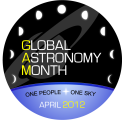GAM 2012 Blog
|
April 15 By Grom Matthies |
Back to the GAM Blog |  |
| For almost all world to see, with a few exceptions at higher southern hemisphere latitudes, this month of April presents us with a unusual spread of major planets spanning all over the sky. | ||
At sundown, bright Jupiter peeks just above the horizon ready to follow the Sun into the abysm of upcoming darkness. Earths neighbour Venus, even brighter than Jupiter, follows a bit after. Facing towards where later the Sun will rise, a slightly yellow-orange tinted Saturn makes his way up into the darkening sky. And finally, near the meridian, a small but clearly orange-red Mars makes its planetary contribution. For early risers, Mercury lurks above the horizon just short before sunrise. Therefore, all planets visible to a naked eye can be spotted this month just in a single night and were it not for Mercury, actually right around night fall.
The word planet comes from old Greek meaning wandering star or errant star. In ancient times, when there were no light pollution and no telescopes, the more curious minds and soles forced to keep a watchful eye all night long for any eventual upcoming harm to local population, noticed that all stars keep their position fixed to each other year after year - with a few exceptions. Those exceptions were thus called wandering stars – or planets as by the Greeks and all of us since then.
Scientifically correct for our ancestors’ point of understanding they counted seven wandering stars, from Mercury to Saturn, excluding Earth, but including the Sun and the Moon. We all know how long human history took to change the knowledge about our solar system. From philosophical turmoil to burning astronomers on the churches inquisition stakes nothing helped, Sun and Moon were demoted from planet status, and Earth turned out to be a planet too.
Just before the very first sunrise in the 19th century asteroid Ceres was discovered. It was big, shiny and it moved around the sun. So, again scientifically correct for its time, it had to be a planet and labelled as such it entered contemporary books for everybody to learn about the 8 planets - Mercury to Uranus, including Earth, plus Ceres. It took almost 50 years since its discovery, but Ceres finally got demoted in textbooks from planet to minor planet and mankind got stuck again with seven planets until Neptune in 1846 raised the bar again to eight.
Does this sound the bells of déjà-vu? Well, Pluto was a normal planet until being demoted to dwarf planet a few years ago. It also took almost 50 years to happen since its discovery.
That history repeats itself is common knowledge, but that it happens in astronomy, what we call an exact science, like physics, mathematics etc., seems somehow curious.
Astronomy actually stands out in somehow doing wrong classification or naming of discoveries. The term planet is just one long lasting example. Nowadays everybody knows the term black hole, but was once, by theorists, called a black star or frozen star, or, correctly describing the object, a completely collapsed gravitational object. If that naming would have stuck, general public probably hardly would ever have heard of them.
It is said that astronomy is currently in its golden age, with tons of exciting discoveries made in the last decades and more to come in the future. As with every discovery, we need to name them. One of those discoveries is the acceleration of the universes expansion. We discovered the fact, not the cause. We named the cause Dark Energy.
History repeats itself and scientists do so too. In 16 th century Copernicus struggled to try to explain what makes our planets run around the sun and objects in the sky apparently spherical, he and his contemporaries called the cause qualitas occulta, dark force – we know it is gravity.
Back to the planets and this year Global Astronomy Month, we, globally, have a chance to glimpse with our naked eyes most of the major planets. Take it a bit further, especially in the first and then again in the last week of April, watch a lovely sunset and then, as the sky darkens, the appearance of one major planet after the other. Compare how the Moon moves kind of backward seen at the same hour from day to day, how Venus and Jupiter change their distance over the month. Seeing the Sun just disappear and the Moon up in the sky, plus all the naked eye planets, you may imagine yourself projected back in time witnessing the wandering stars and thinking about a proper name. Call them all planets and you close the loop that spans over almost 5000 years, Babylonians on one end, you on this end. Naked eye astronomy and human history all in one. Have fun and clear skies.
|
|
Grom D.Matthies prefers daylight and thus studies the Sun and its influence on Earthlings for over 3 decades. He authored astronomical yearbooks and his work is to bring the Sun and starlight to schools and into young peoples mind all over Portugal. |








